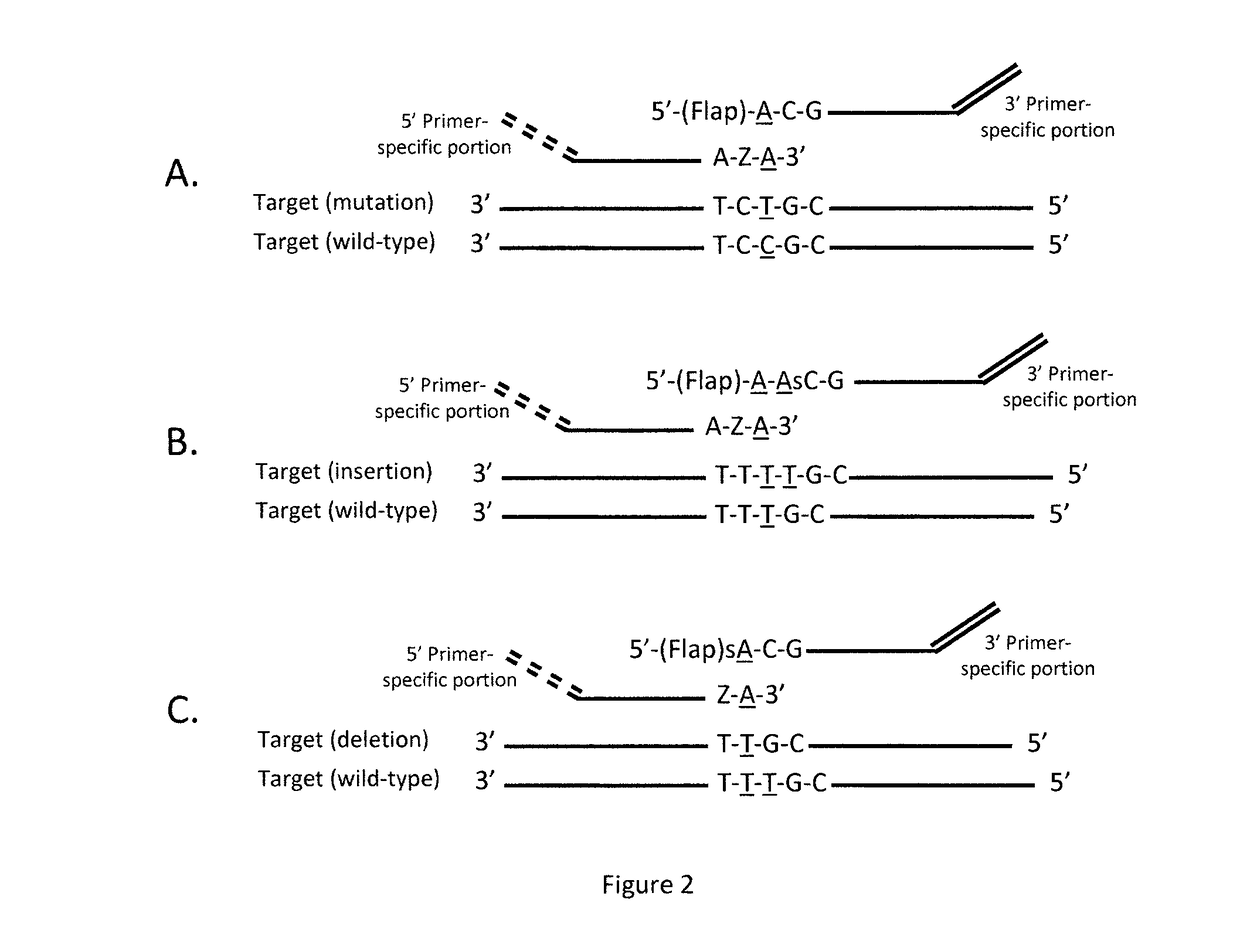Method for relative quantification of nucleic acid sequence, expression, or copy changes, using combined nuclease, ligation, and polymerase reactions
a technology relative quantification, which is applied in the field of relative quantification of nucleic acid sequence, expression or copy change, using combined nuclease, ligation, and polymerase reactions, can solve the problems of unsatisfactory false positive, limited ligation detection reaction/ldr/pcr methods, and multiplex polymerase chain reaction (pcr), etc., to achieve the effect of reducing the amount of sample required
- Summary
- Abstract
- Description
- Claims
- Application Information
AI Technical Summary
Benefits of technology
Problems solved by technology
Method used
Image
Examples
##ic example 1
Prophetic Example 1
Detection of Highly Sensitivity Mutation Marker (Present at 1% to 0.01%); Repeat Mutations in Known Genes
[0113]Mutational changes in oncogenes are usually in discrete regions or positions and can often drive tumor progression. A list of these genes and their mutations may be found in public databases such as the Sanger Genome Center “COSMIC” database. Presence of such mutations in serum is a strong indicator of some tumor tissue in the body. Traditionally such mutations have been identified using allele-specific PCR amplification. This approach is susceptible to an initial false-amplification, followed by amplification of the false product. Others have used digital PCR to try to quantify mutant DNA in the serum.
[0114]Overview of approach: This approach depends on the fidelity of two enzymes: (i) the polymerase 5′→3′ nuclease or flap cleavage enzyme in discriminating a match from mismatch on the 5′ side of the downstream primer, and (ii) the ligase in discriminatin...
##ic example 2
Prophetic Example 2
High Sensitivity Mutation Marker (Present at 1% to 0.01%); Uncommon Mutations in Known Genes
[0196]Mutational changes in tumor suppressor genes such as p53 and APC are too numerous to cover using allele-specific PCR approaches. Thus, the approach has shifted to deep sequencing across all exons of the protein. When input DNA is limiting, it is important to achieve equal amplification of different regions to assure the same general depth of coverage.
[0197]Overview of Approach:
[0198]The idea is to faithfully make a copy of all exons that are present and do a limited equal amplification of all prior to sequencing. While others use tricks like cold-PCR to enrich for wild-type fragments, such an approach is vulnerable to SNPs within the genes of interest. Further, such enrichment approaches are unlikely to amplify fragments equally, leaving the task of deep sequencing anyway.
[0199]To copy all exons, an upstream ligation probe is paired with a downstream ligation probe th...
##ic example 3
Prophetic Example 3
Accurate Quantification of Tumor-Specific mRNA Isolated from Exosomes
[0208]In the past few years, several groups have captured tumor-specific exosomes, which contain miRNA and mRNA that is specific to the original tumor cell. Accurate quantification of these markers may help identify early cancer, as well as provide signatures for predicting outcome. Traditionally, relative levels of mRNA expression are determined using reverse-transcription—real-time PCR.
[0209]Overview to approach: Here the idea is to count how many copies of mRNA from a dozen or so genes are present in the sample. An initial reverse transcription step makes DNA copies of all desired regions of mRNA, and then one or two ligation probe pairs per transcript can be used to accurately quantify the amount of each transcript of interest.
[0210]The challenge here again is to avoid having polymerase extend the upstream probe in such a way that it destroys the downstream probe without a ligation step. This...
PUM
| Property | Measurement | Unit |
|---|---|---|
| temperature | aaaaa | aaaaa |
| temperature | aaaaa | aaaaa |
| temperature | aaaaa | aaaaa |
Abstract
Description
Claims
Application Information
 Login to View More
Login to View More - R&D
- Intellectual Property
- Life Sciences
- Materials
- Tech Scout
- Unparalleled Data Quality
- Higher Quality Content
- 60% Fewer Hallucinations
Browse by: Latest US Patents, China's latest patents, Technical Efficacy Thesaurus, Application Domain, Technology Topic, Popular Technical Reports.
© 2025 PatSnap. All rights reserved.Legal|Privacy policy|Modern Slavery Act Transparency Statement|Sitemap|About US| Contact US: help@patsnap.com



